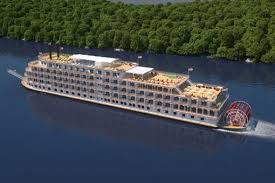
American Cruise Lines’ Queen of the Mississippi. Photo from American Cruise Lines
I’ve written several times previously about the hot European river cruising market (most recently here).
But the U.S. river cruising market is getting torrid as well, thanks in large part to American Cruise Lines, a family-owned company whose six small ships cruise rivers and waterways throughout America. Nearly three dozen itineraries range from the islands of New England to Alaska’s Inside Passage, the Intracoastal Waterway of the southeastern U.S. to the Columbia River in the Pacific Northwest, and many points between — including the mighty Mississippi.
Late last week I attended a luncheon in New York City with American Cruise Line executives aboard one of their ships, the Independence, a three-year-old vessel that holds a maximum of 104 passengers.
The Independence was temporarily docked at Chelsea Piers in Manhattan after completing a fall foliage cruise along the Hudson River; later that day, it would sail toward Baltimore and the Chesapeake Bay.
Over regional specialties like Maryland crab cakes and New England lobster sliders, I learned a number of things about this impressive cruise line, which has one of the world’s newest fleets of cruise ships.
All are small as judged by the number of cabins — holding anywhere from a maximum of 49 passengers to 150 — but large in terms of passenger space.
Cabins are roomy and many have good-sized balconies. There are also spacious lounges and other public areas, including observation decks and glass-enclosed dining rooms, which offer open seating at meals.
Two of the ships — the 2012-built Queen of the Mississippi and the 1995-built (and 2011-renovated) Queen of the West — are atmospheric old-style paddlewheelers.
Business is booming, currently growing at 25 percent a year. American Cruise Lines has two more ships under construction and three more will follow, one per year beginning in 2015. All the ships will carry no more than 200 passengers each.
Most important for this blog, their main target market is baby boomers.
“Baby boomers are our future, moving forward. With 10,000 boomers reaching retirement age each day now, that makes us smile,” director of marketing Charles B. Robertson told me. (Robertson is the son of Charles A. Robertson, chairman and CEO of the line, who founded the company when it had only one ship. Two of his other sons also work for the company.)
I asked both Robertsons what baby boomers are looking for in a river cruise.
“They’re much more engaged than previous generations,” Charles B. replied. “They’re active, they’re diligent, and they’ve done their homework when they come on board. They know exactly what they want to do and they look for us to help them do it, to ease their way.”
“Baby boomers are also more demanding than previous generations,” his father added. “And that’s why we’re capturing that market. We give them want they want.”
Along with more space (“People won’t tolerate small staterooms any more,” Charles Sr. contended), one thing boomers want is highly personalized service, which American Cruise Lines considers its watchword. “One repeat customer wanted oysters at 3 o’clock every afternoon,” Charles Sr. said. “She got her oysters.”
That kind of service has resulted in about 40 percent repeat passenger business each cruise, one of the highest rates in the industry. Almost 30 percent of passengers book their next cruise during their current cruise, which earns them a small discount.
Otherwise, discounting is unusual and rates are on the pricey side, but are all-inclusive (including alcoholic beverages) except for shore excursions — and those are included in Alaska.
Itineraries are heavily destination oriented, with port stops nearly every day of each cruise. Lengths vary from six to 14 nights, with week-long voyages the most typical. Historical and cultural lectures are offered on each cruise, and a number of themed cruises are also offered throughout the year: Lewis and Clark on the Columbia and Mark Twain on the Mississippi among them.
Sales Director Susan Shultz noted three trends that she sees emerging for the cruise line:
They’re adding more single cabins to their new ships — at rates less than typical single supplements run;
Passengers are booking more back-to-back cruises, sometimes three or four in a row — indicating that baby boomers now have more time to spend traveling;
And they’re seeing more multi-generational travel, with boomers accompanied by their children and grandchildren. Connecting rooms are available if needed.
I came away from lunch thinking that American Cruise Lines is pushing all the right buttons to attract baby boomers.
And this is one baby boomer who will definitely be on board next year, blogging as I go.
What do you think, readers? Is river cruising ever going to overtake ocean cruising in popularity? I hear from people frequently who say they didn’t even know there is such a thing as river cruising — and now they want to try it. Are travel agents doing enough to inform their clients about this option? Are advertisers failing to reach the public? I’d welcome your thoughts.
Be sure to download my free report, “How to Ride the Coming Wave of Boomers,” available here. It’s all about the best ways to market travel to baby boomers — the biggest-spending group of travelers the world has ever seen. It’s also the easiest way to subscribe to my blog, so you won’t miss a posting. Thanks!












2 Responses to American Cruise Lines Entices Baby Boomers on U.S. Waterways